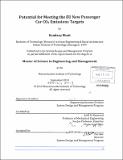Potential for meeting the EU new passenger car CO₂ emissions targets
Author(s)
Bhatt, Kandarp
DownloadFull printable version (22.33Mb)
Alternative title
Potential for meeting the European Union new passenger car CO₂ emissions targets
Other Contributors
System Design and Management Program.
Advisor
John B. Heywood.
Terms of use
Metadata
Show full item recordAbstract
In 2009, the European Parliament agreed to limit the CO2 emissions from new passenger cars sold in the European Union to an average of 130g/km by 2015. Further, a probable longer-term CO2 emissions target of 95g/km is specified for 2020. This thesis attempts to assess the feasibility of meeting these targets in a representative European Union by developing and evaluating Optimistic and Realistic scenarios of varied powertrain sales mix, vehicle weight reduction levels, and Emphasis on Reduction of Fuel Consumption (ERFC) using a European New Passenger Cars CO2 Emissions Model. Further, this thesis develops custom fleet models for select member states to understand the impact of the developed scenarios on reduction of fuel use and on the diesel to gasoline fuel use ratio. The thesis finds that while the European Union is poised to meet the 2015 target in an Optimistic scenario, it will find it difficult to do so in a Realistic scenario. Moreover, the 2020 target would not be achieved in either of the two scenarios. Further, the diesel to gasoline fuel use ratio will continue to rise through year 2020 for the studied countries, potentially reaching as high as 3 in the case of France and at least as high as 0.71 in the case of Germany. Finally, an increase in ERFC and introduction of PHEVs would most help reduce fuel use in all studied countries. In France and Italy, a reduction of Diesel car sales would additionally be significantly useful in reducing the fuel use. Whereas, in Germany and UK, a higher number of Turbocharged Gasoline cars would be another significant option to reduce fuel use.
Description
Thesis (S.M. in Engineering and Management)--Massachusetts Institute of Technology, Engineering Systems Division, System Design and Management Program, February 2011. Cataloged from PDF version of thesis. Includes bibliographical references (p. 84-87).
Date issued
2011Department
System Design and Management Program.; Massachusetts Institute of Technology. Engineering Systems DivisionPublisher
Massachusetts Institute of Technology
Keywords
Engineering Systems Division., System Design and Management Program.